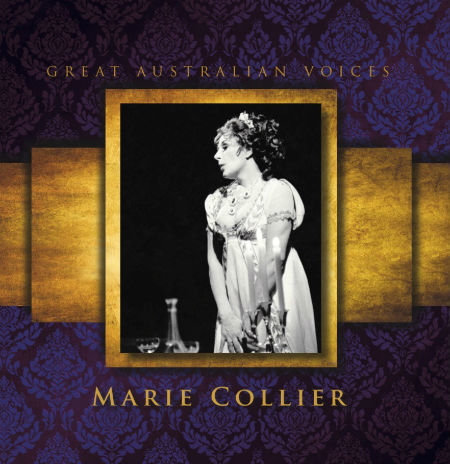
MARIE COLLIER “Great Australian Voices'

Desirée records GAV 007
click here to order the CD
As a Fleming I got to know the voice of Marie Collier (1927-1971) through the English language Butterfly she recorded and which I found in a London second hand store more than three decades ago. I still have the LP. The voice was a revelation and my ears asked for more but much more there wasn’t except for the Solti Elektra which eventually I got as well. Neither could I find a lot about the Collier persona except that an older collector told me she had committed suicide by jumping out of a window. This outstanding three CD release by the Desiree company not only sets the record straight about her death which was clearly an accident –all explained in detail in the booklet- but offering a wealth of fine recordings hitherto unknown and unavailable.
The first and second CD mainly contain arias, duets and ensembles from Italian operas. In the “vissi d’arte” (rec.1968) and especially in the Tabarro (1965) Collier gives proof of a very warm and Italianate lyric spinto with a slight hint of a Brouwenstijn-Olivero like vibrato. As Giorgetta she’s a forceful personality with an undeniably electric quality to her singing and Charles Craig is a convincing Luigi. Collier’s very feminine Santuzza (Voi lo sapete rec. 1966) has the necessary burning intensity needed for the role and her Aida excerpts from the same year offer immensely satisfying singing and no high C problems in “O patria mia”. She’s partnered in the Nile scene by an eloquent Charles Craig as Radamès (spelled Radamés in the booklet). The Australian soprano is not in vocal peak form in the duet from Manon Lescaut (rec.1968) yet she always rises to the emotional levels called for by the role. The underrated Robert Ilosfalvy as des Grieux is excellent and the duet is interrupted by public approval something I never experienced before and this by the “reserved” Covent Garden public !
At the same house but 8 years earlier she’s a winning, noble and delicate Liù under John Pritchard. Pritchard also conducts -very slow - her “Tu che la vanita” (1963) and Collier delivers the tragic queen’s lines with great taste, feeling but also dramatic involvement. On CD 2 the six tracks from Tosca (rec.1968) feature a manly and engaging Cavaradossi by Donald Smith and the greatest post-WWII Scarpia : Tito Gobbi. Collier’s secure Tosca is sung with an imposing presence and also here the first act duet draws applause even before it ends.
Non-Italian tracks include her vivid and fervent Gutrune (War das sein Horn?) from a 1963 Prom concert under Solti - brilliant - and Collier more than stands her own against the vicious Gottlob Frick as Hagen. We can also hear her shimmering and enchanting Lisa in an English language Pique Dame under the legendary Bolshoi conductor Alexander Melik-Pashayev (rec.1961). The second CD concludes with “Now I am sure” from Janacek’s Makropoulos Case (rec. 1971) which ends in a huge ovation from the listeners.
The third Cd is primarily made up of Collier’s “modern” opera appearances . In “The Consul” Collier is absolutely convincing as the desperate Magda Sorel showing no problems at all with the taxing outbursts of despair in ‘To this we’ve come’ (rec.1968). As Jenufa she offers intensity, insight and sincerity to the role and this also applies to her interpretation of Mila Valkovà (rec.1971) in Janacek’s “Osud”. We also get more than 18 minutes from Walton’s Troilus and Cressida (rec.1962) in which she is partnered by an excellent André Turp. She’s vibrant and more Italianate than any other interpreter of the role on record.
There are also two brief excerpts from Tippett’s King Priam (rec.1962) which are the least interesting on the CD. Much more appealing are the excerpts from Shostakovich’s “Katerina Ismailova” (rec.1963) and Prokofiev’s Fiery Angel (rec.1965). Both taxing parts pose no problems for Marie Collier; in fact the voice soars as freely as can be and the roles enable her again to prove herself as a skillful and appealing vocal actress.
As a bonus we also get some affecting examples of her early career. These include “Count your blessings” (rec.1953), Mimi’s “Donde lieta usci” (the only memento of her Mimi) and Santuzza’s “Voi lo sapete” which were both recorded during her study in Milan in 1955 . The earliest surviving recording of her voice is the Aida-Amonasro duet (1951 with Robert Allman) and Ivor Novello’s “We’ll gather Lilacs” (rec.1952). The voice is still somewhat green, the vibrato more pronounced than later but it’s obvious there’s a great voice in the making as is shown above all in the Novello dittie where she already displays some Anna Moffo like sensuality.
This lavishly produced set includes a 52 page booklet illustrated with rare photos, several of them provided by Barbara Kosinski (Collier’s daughter) who also wrote her personal memoirs of her mother. The booklet also includes an in-depth biography by Kim Kemmis.
May this series continue for a long time to come.
Rudi van den Bulck, October 2017